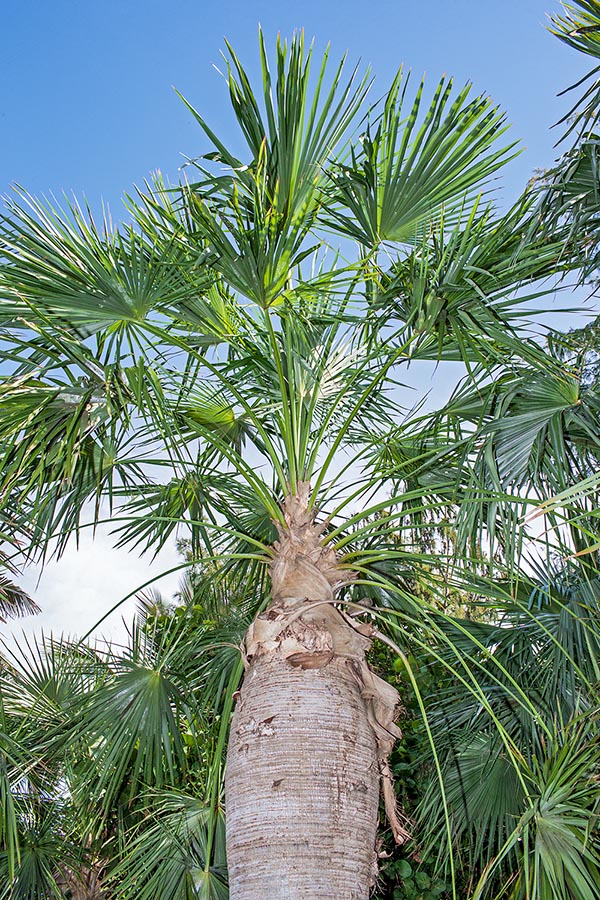Family : Arecaceae

Text © Pietro Puccio

English translation by Mario Beltramini

Endangered by anthropization, due to the use of leaves and pastoralism, Coccothrinax spissa of Hispaniola can reach the height of 9 m with stem of 20-30 cm, often swollen at the centre © Giuseppe Mazza
The species is native to Hispaniola where it grows in the margins of the forests and in semiarid open areas, characterized by a mainly xerophilous vegetation, on rocky calcareous soils, from the sea level up to about 400 m of altitude.
The generic name comes from the combination of the Geek term “κόκκος” (coccos) = berry and of the nme of the genus Thrinax, to which these plants resemble; the specific name is the Latin adjective “spissus, a, um” = compact, dense, thick, with reference to the compact inflorescence.
Common names: guano palm, swollen silver thatch palm, Hispaniola belly palm (English); guano, guano barrigón, guano manso (Dominican Republic).
The Coccothrinax spissa L.H.Bailey (1939) is a solitary unarmed monoecious species, up to about 9 m tall, with robust stem of 20-30 cm of diameter, often with a characteristic swelling towards the central part, of greyish colour.
The leaves, on a 45-50 cm long and 1,6-2 m broad, are palmate almost orbicolar, 0,8-1,2 m broad, of dark green colour above, covered by a thin silver white tomentum below, incised in 38-50 linear-triangular fairly rigid segments, but at the apex, bifid, that is slightly drooping, 70-75 cm long and 2,5-3 cm broad at the centre, united at the base for a length of about 20 cm.
The foliar base is provided on the margins of thin pale brown fibres, about 0,5 mm thick, thickly arranged in two layers, wrapping the stem in the youngest part.
Inflorescences between the leaves (interfoliar), 25-40 cm long, initially ascending, curved and under the leaves in fruit, ramified, compact, with 3-4 primary ramifications and several rachillae, 8-11 cm long, bearing hermaphroditic flowers on a 1-3 mm long pedicel. The fruits are globose, of 0,9-1,2 cm of diameter, of blackish purple colour when ripe, containing one sole cerebriform seed of 0,4-0,8 cm of diameter.
It reproduces by seed, previously kept in water for three days, in sandy loam maintained humid at the temperature of 26-28 °C, with germination times starting from about one month.
Species with rather slow growth, rarely present in cultivation, that distinguishes from the congenerous species for the robust stem that in many specimens has a curious swelling towards the central part. Cultivable in the tropical, subtropical climate zones and, marginally, in the warm temperate ones, where it can resist when adult to occasional decreases of temperature up to about -1 °C for short times. It grows, preferably in full sun, on various kinds of soil, even poor, provided perfectly draining, with a preference for the rocky calcareous ones. It can stand periods of drought, but in cultivation takes advantage from regular waterings in the areas characterized by marked seasonal climates with long periods of dry warmth. It moderately bears the salty winds, hence can be employed in gardens close to the sea.
The leaves are utilized as cover of rural dwellings and for realizing ropes, mats, bags, brooms and other handicrafts of common use. Due to the expansion of the urban settlements and of the agricultural areas, that have drastically reduced its habitat, and of the stock-breeding, that reduces its natural regeneration, the number of individuals in natura has drastically decreased, so much to endanger its survival.
Synonyms: Pithodes spissa (Bailey) O.F.Cook (1941).
